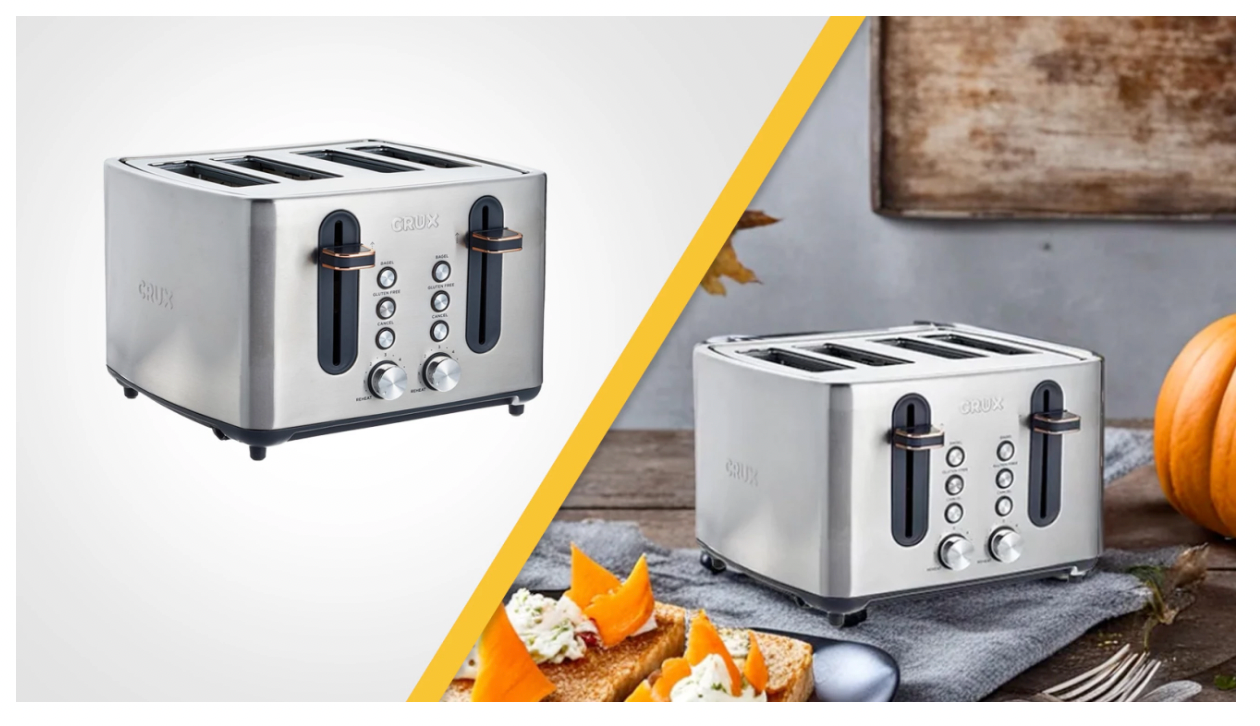Amazon PPC Advertising: 2024 Ultimate Guide for Beginners - Jungle Scout
Content
expand_moreIf you want to be successful on Amazon in 2024 and beyond, you need to have a good Amazon PPC management strategy.
Amazon Pay-per-Click (PPC) advertising is part of Amazon's internal advertising system. Through Amazon PPC, brands, agencies, and third-party sellers can target specific keywords to create advertisements for their products, which appear in Amazon's search results and competitor product listings.
That way, sellers can present Amazon customers who are ready to make a purchase with relevant products at the point of sale — and then measure their ads' performance to identify which specific ads are driving conversions. It's a highly effective marketing technique that three out of four Amazon sellers of all types and sizes utilize.
We'll take an extensive look at each of the different types of PPC Amazons ads and how to set them, along with recommendations for strategies that Jungle Scout's expert Amazon sellers use for their own businesses.
What is Amazon PPC?
Amazon PPC is the advertising platform Amazon makes available to its third-party sellers. It allows sellers to create ad campaigns for their products and then charges them each time a potential customer clicks and views their ad.
Before we get into the details of PPC though, it's important to understand Amazon's key PPC metrics. This is how Amazon describes each one:
- Advertising Cost of Sales (ACoS): The percent of attributed sales spent on advertising. This is calculated by dividing total ad spend by attributed sales. For example, if you spent $4 on advertising resulting in attributed sales of $20, your ACoS would be 20% (ie. $4/$20 = 0.20).
- Attributed Sales: The total product sales generated within one week of clicks on your ads. Your sales data can take up to 48 hours to populate so, as a result, sales data is not available in the 'Today' date range and may be delayed to the 'Yesterday' date range. You can view the individual sales totals for advertised products and other products in the Campaign Performance report.
- Impressions: The number of times your ads were displayed. Once identified, it may take up to three days to remove invalid clicks from your reports. Clicks from the last three days may be adjusted due to click invalidation.
- Clicks: The number of times your ads were clicked. Once identified, it may take up to 3 days to remove invalid clicks from your reports. Clicks from the last three days may be adjusted due to click invalidation.
READ MORE | How Much Does Amazon PPC Cost?
Why is PPC important for Amazon sellers?
As consumer shopping increasingly shifts online — and, overwhelmingly, to Amazon.com — ecommerce brands and sellers have immense opportunities to succeed. But with that influx of online retail traffic comes more competitors looking to capture the most sales.
In 2024, having an effective PPC advertising strategy is all but essential for Amazon businesses of all sizes. After all, there are over hundreds of millions products on Amazon, and listings can easily get lost in the noise.
And while your organic ranking — the place where your product appears in search results naturally — is important, advertisements help increase your reach on the platform.
How to create an Amazon PPC strategy
Here are the basic aspects of building a solid Amazon PPC management strategy:
- Experimentation. Test out each type of PPC ad campaign, and play around with automatic and manual keyword targeting to see what's best for your brand.
- Research. Perform detailed keyword research using Jungle Scout's Keyword Scout, focusing both on related keywords and competitor products.
- Budget. When starting out, set daily budgets and default bids 50-100% higher than what Amazon recommends.
- Duration. Let ad campaigns run for at least two weeks before running reports and making adjustments.
- Campaign types. Use ad reports from your automatic campaigns to find keywords for your manual campaigns. Before adjusting or removing a keyword from a manual campaign, make sure the keyword gets at least 10 clicks.
- Review. Continue reviewing your ad reports once a week, subtracting, adding, and adjusting keywords as needed.
Choosing which type of Amazon PPC advertising is right for your business
Amazon offers sellers several different types of PPC ads to use, with customizable targeting options.
When starting out, we recommend that you try all of the ad types available to you, especially automatic-targeting ads and manually targeting Sponsored Products ads. These two ad types help you get the best picture of what sorts of keywords and search terms you should target on Amazon.
Understanding RoAS
We'll go over all of your PPC options below.
But first, it can be helpful to consider your strategy in terms of your estimated return on ad spend (RoAS), especially when working with a constrained ad budget. In other words, you'll want to consider how much revenue you'll earn in sales for every dollar you spend on your ads.

Certain ad types and strategies yield a higher RoAS than others. For example, running Sponsored Brand ads generates the most sales of all the PPC types, as do close and loose match keyword targeting strategies.
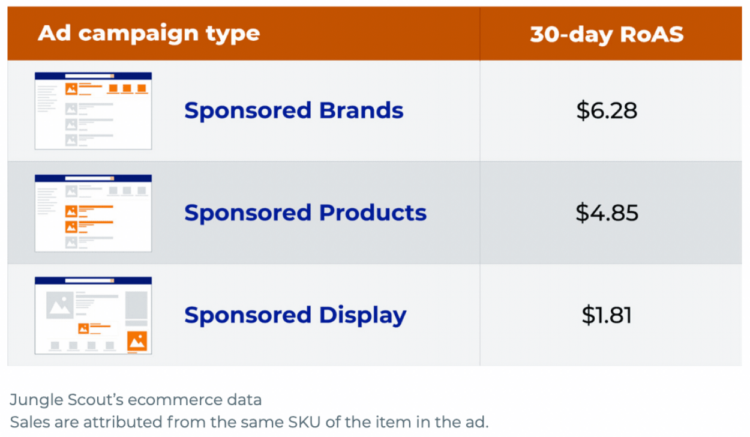
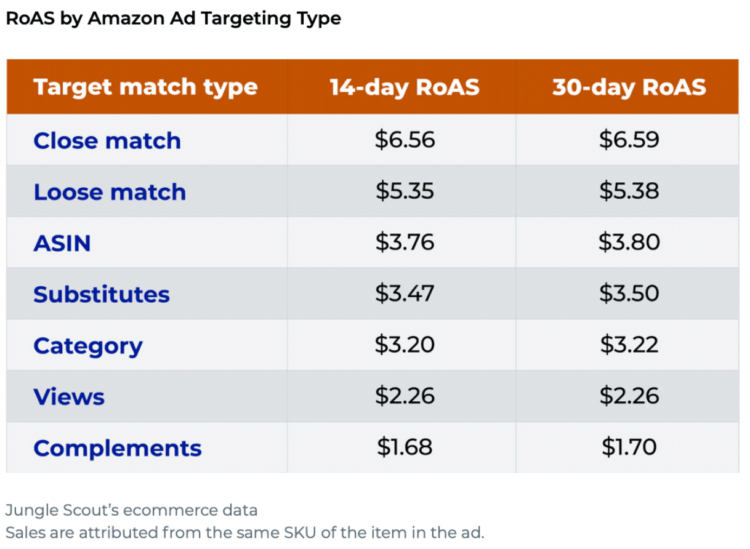
The price of your products matters, too. While RoAS generally increases with a product's price, those in the $21-$30 price range hit a sweet spot, with a greater RoAS than both more and less expensive products.
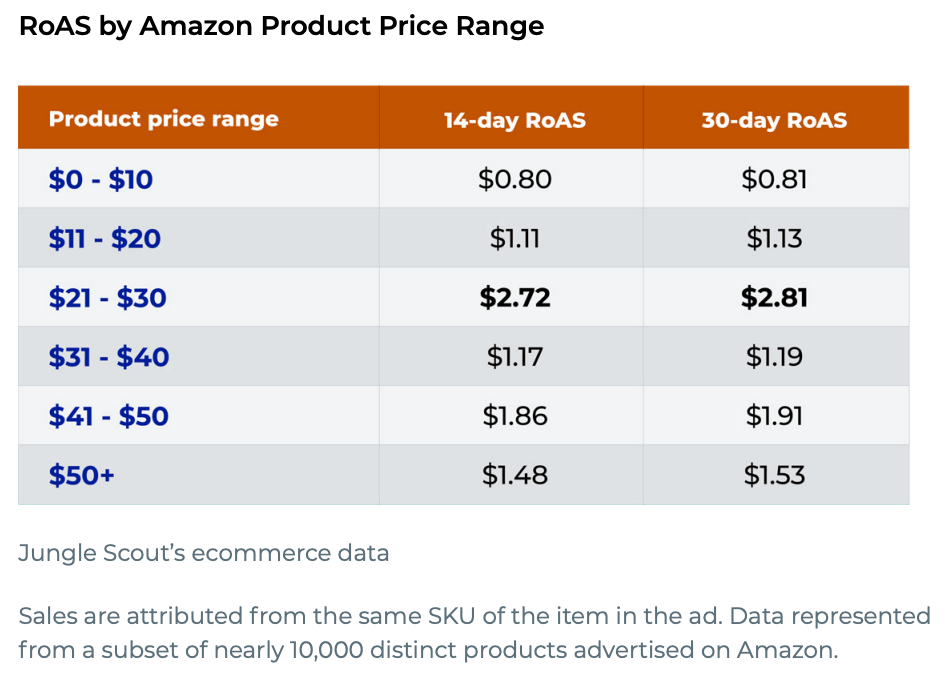
Of course, it takes time and practice to optimize PPC campaigns, and your mileage may vary. But knowing a ballpark return on investment can help guide your decisions.
It can be difficult at first to figure out what specific PPC strategy will benefit your brand the most — managing PPC bids is one of the most common challenges among SMB sellers. By trying out each of the ad types, you can find out what works for you and what doesn't. Then, once you have enough data, you can remove ads that you feel aren't working while boosting those that do perform well.
Types of Amazon PPC ads
79% of Amazon SMB sellers advertise their products on or off Amazon. Of those, here is the breakdown of sellers who use Amazon Pay-per-click (PPC) advertising:
- 77% use Sponsored Products ads
- 39% use Sponsored Brands ads
- 30% use Sponsored Display ads.
Let's discuss the types of Amazon PPC ads available, in order of their popularity among third-party sellers:
- Sponsored Products ads
- Sponsored Brand ads
- Sponsored Display ads
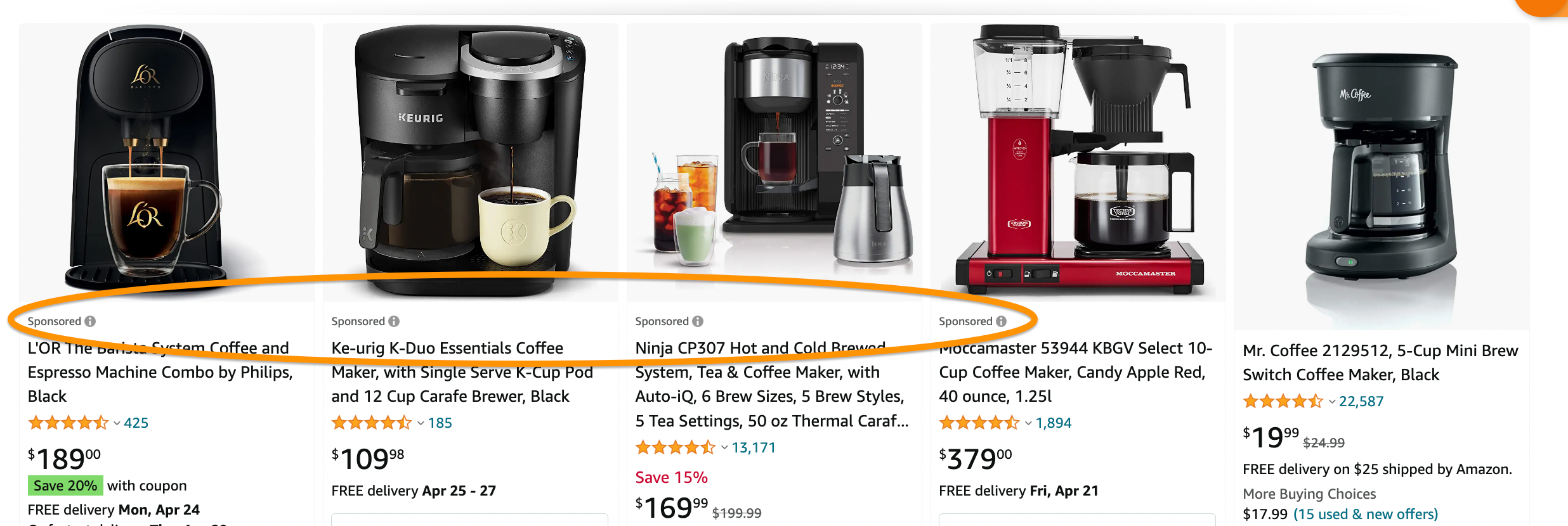
Sponsored Products ads appear in search results and product listing pages, and can closely resemble organic listings. This is the most common type of Amazon PPC ad, used by 66% of third-party sellers.

When creating Sponsored Products ads, there are two types of keyword targeting strategies a seller can use: automatic targeting and manual targeting. Let's explore their differences.
Automatic targeting
The automatic strategy involves targeting keywords that Amazon's algorithm determines are related to your product listing. Over time, Amazon uses data that it collects from shoppers' clicks and purchases, then adjusts the ads to better suit your listing and increase conversions.
Within automatic targeting, sellers can use four different keyword match types:
- Close match ads: Appear when shoppers use search terms that are closely related to the product you're advertising
- Loose match ads: Appear when shoppers search keywords loosely related to your product
- Substitutes: Target shoppers who are considering products that are similar to your product but sold by a different brand (e.g., a Cuisinart blender instead of a KitchenAid blender)
- Complements: Target shoppers viewing detail pages of products that complement yours (e.g., paintbrushes to go with a paint set)
As "automatic" implies, this is the easier targeting method from a seller's perspective. The downside is that it lacks the optimization options that other ad types offer.
Manual targeting
Manual targeting involves hand-selecting the keywords you want to bid on. Manually targeted ads will only appear if a shopper's search terms match your chosen keywords. As a more "hands-on" type of ad, you will need to monitor changes in costs and make adjustments where applicable. This optimization often results in more effective ads and a lower long-term ad spend.
2. Sponsored Brands ads
Sponsored Brands ads, formerly known as "headline search ads," allow sellers to drive awareness to more than one product at a time and catch shoppers' eyes with more robust visuals than with Sponsored Products.
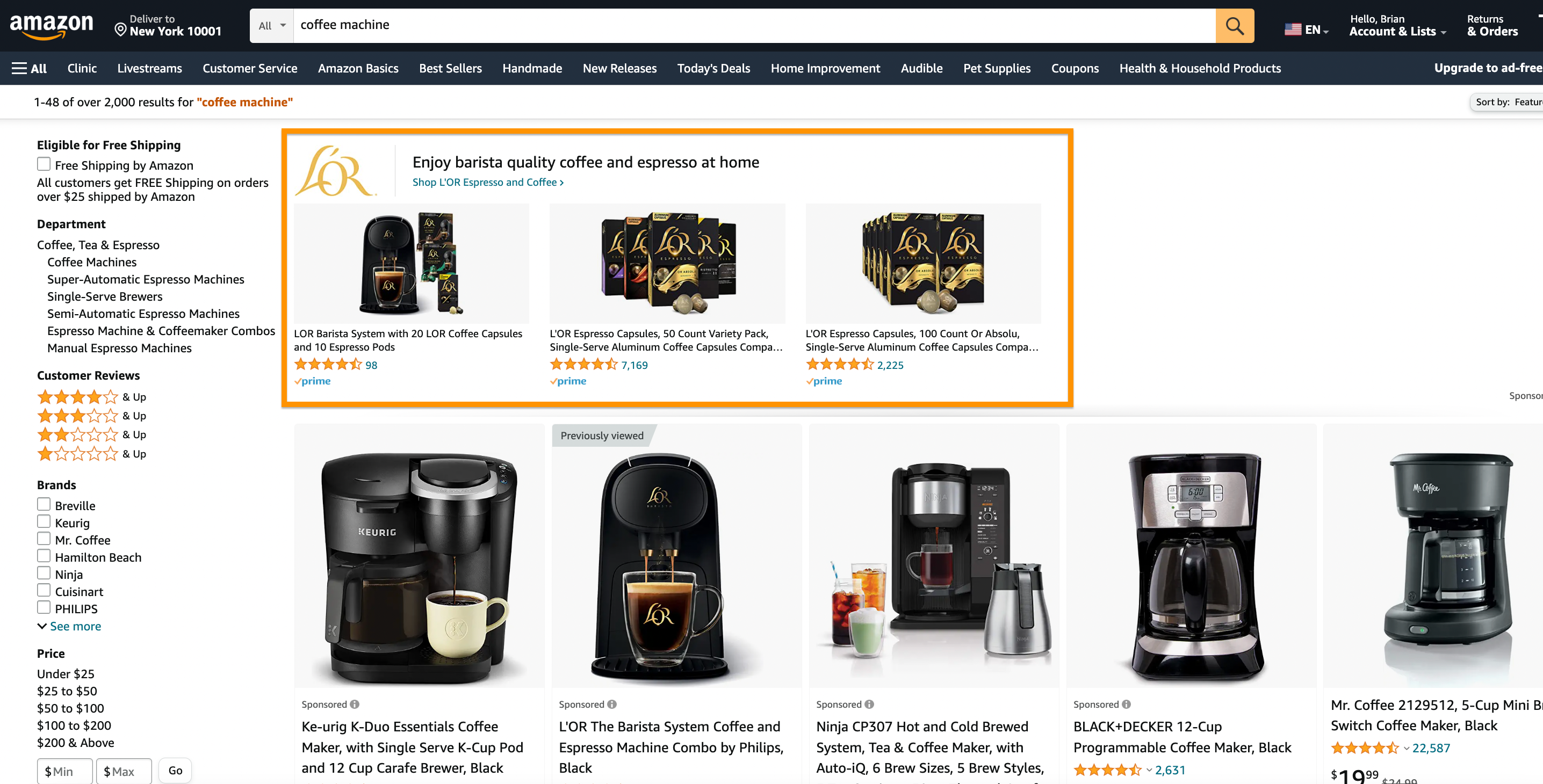
With Sponsored Brands, sellers can choose from three formats, which can appear either at the top of Amazon search results as headline banners or further down the page as a video.

"Product collection" and "store spotlight" ads typically include the brand's logo, custom tagline, and two or more products, whereas the "video" format includes a 15-30 second-long video showcasing a single product.
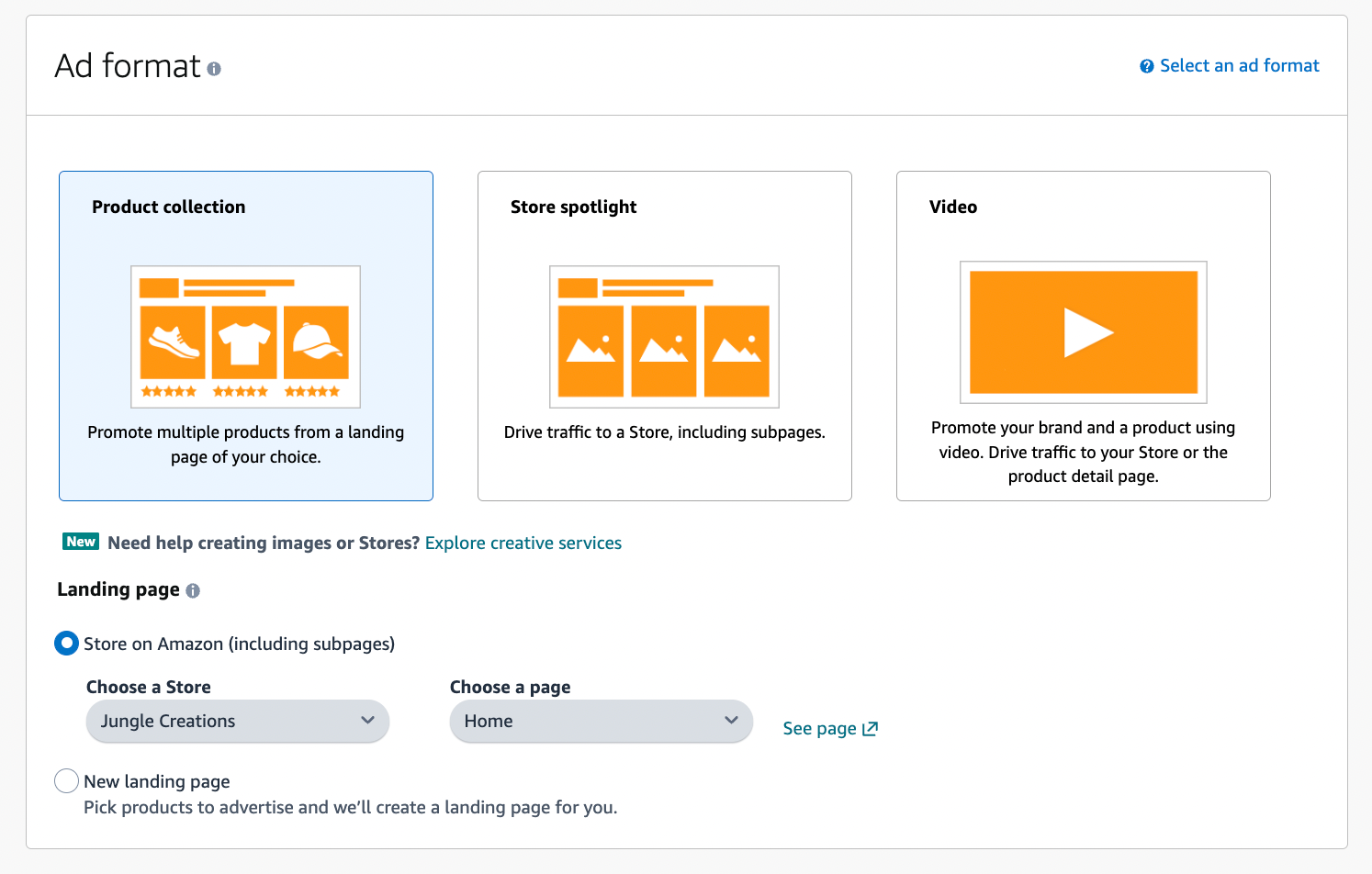
When clicked, these ads navigate the customer to a custom landing page or a brand's Amazon Storefront.
Sponsored Display ads allow sellers to retarget customers who have visited their product detail pages, on and off Amazon. Unlike Sponsored Products and Sponsored Brands ads, Sponsored Display ads can appear on Amazon's affiliate sites, including Google, Facebook, Netflix, and even mobile phone apps. Like Sponsored Brands ads, a seller must have a registered brand in order to utilize them.
Off-Amazon Sponsored Brands ads:
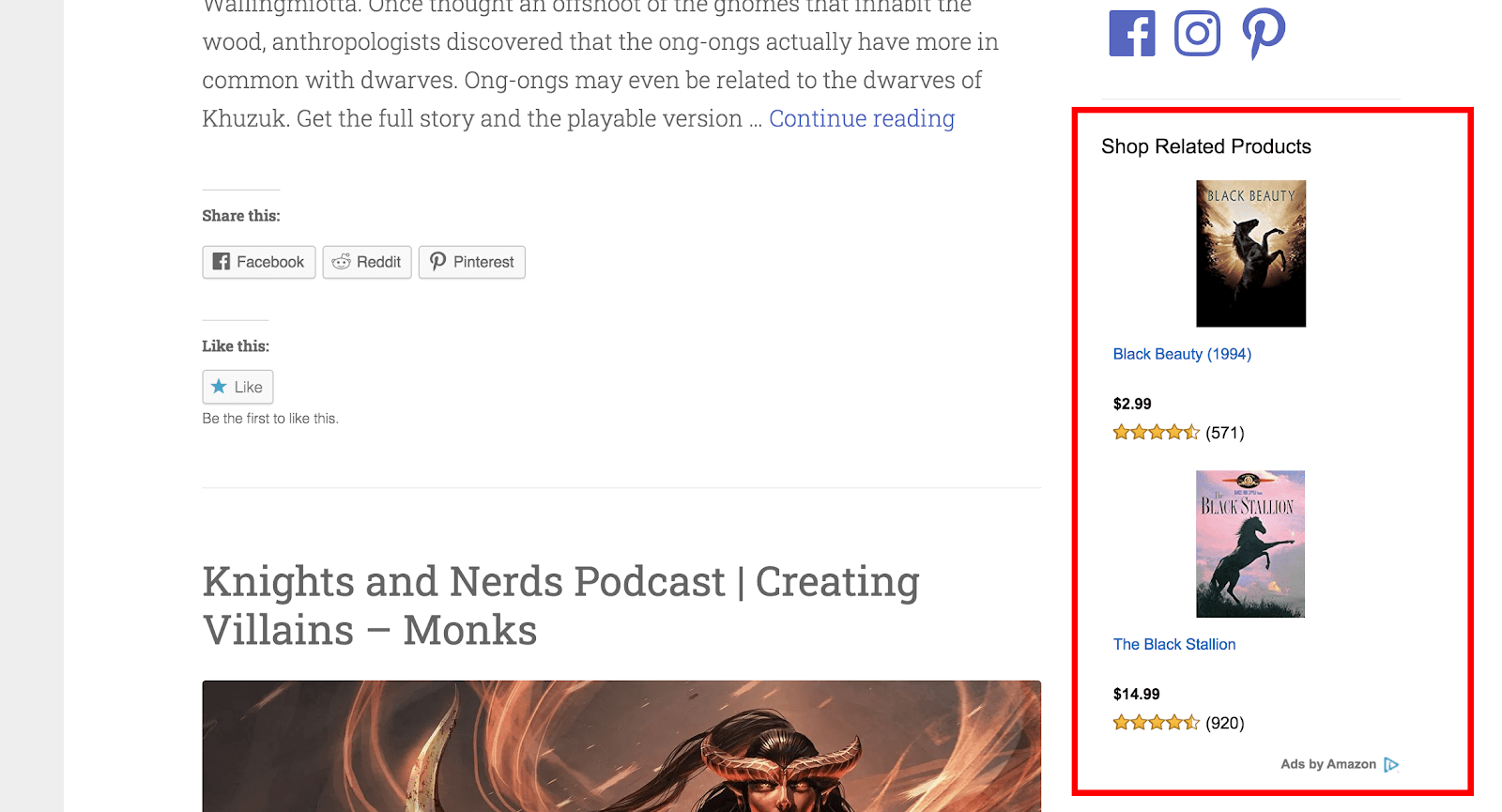
On-Amazon Sponsored Brands ads:
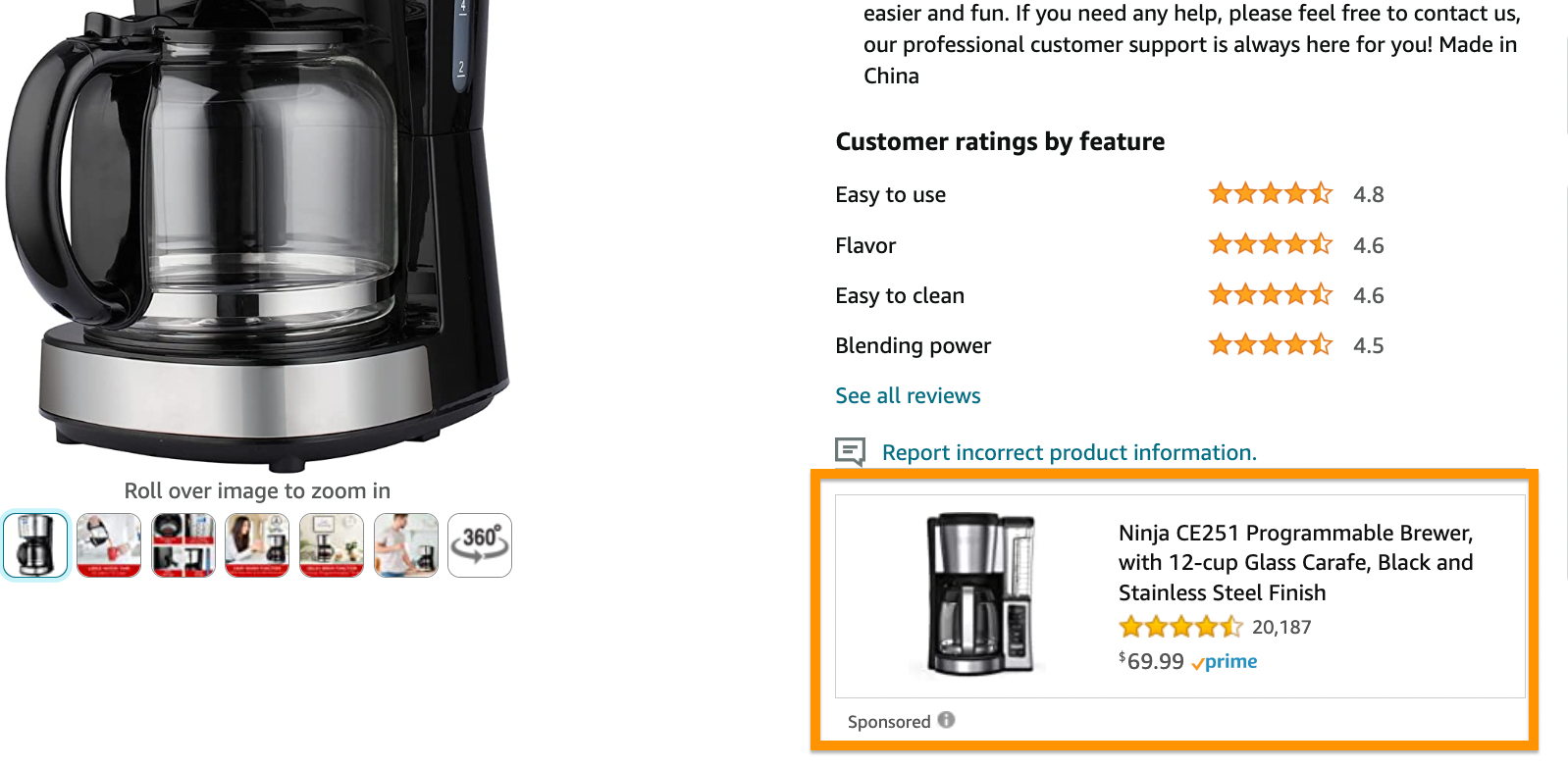
Sponsored Display is the newest type of PPC, and hasn't quite reached the popularity of Sponsored Products and Sponsored Brands: just 25% of third-party Amazon sellers use Sponsored Display PPC ads.
How to use AI to improve your Amazon ads
Amazon is making it easier for brands to create lifestyle imagery that helps improve their ads' performance with AI-powered image generation.
Instead of spending time creating (or paying for) a unique lifestyle image for your ads or using your product image with a plain white background, you can enter a prompt for what you want as the background for your product, and the AI-powered tool will generate an eye-catching image to use in your Sponsored Brands Ads.
As stated by Amazon, "For example, an advertiser may have standalone images of their product against a white background, like a toaster. When that same toaster is placed in a lifestyle context—on a kitchen counter, next to a croissant—in a mobile Sponsored Brands ad, click-through rates can be 40% higher compared to ads with standard product images."
